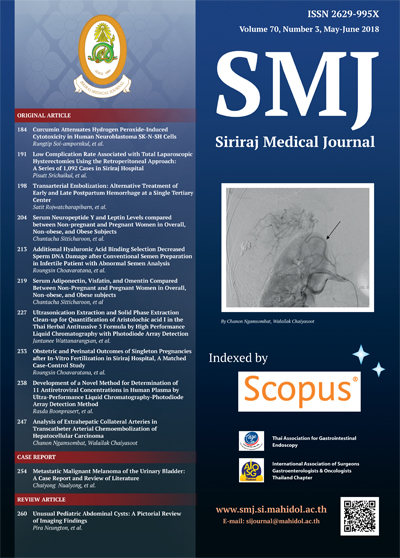Development of a Novel Method for Determination of 11 Antiretroviral Drugs Concentrations in Human Plasma by Ultra-Performance Liquid Chromatography- Photodiode Array Detection Method
Keywords:
UPLC/PDA; antiretroviral; therapeutic drug monitoringAbstract
Objective: To develop ultra-performance liquid chromatography-photodiode array detection (UPLC-PDA) method that is fully validated for measuring 11 antiretroviral drugs concentrations in human plasma.
Methods: Chromatographic separation was performed on an ACQUITY UPLC™ BEH Shield RP, 1.7 μm (100 mm x 2.1 mm I.D.) and used acetronitrile with 0.1% formic acid in Milli-Q water as a mobile phase. ACQUITY UPLC®
Photodiode Array (PDA) Detector was performed at 210, 240, and 260 nm.
Results: This method demonstrated a good separation result for plasma levels of 11 antiretroviral drugs within 16 minutes. The lower limit of quantification (LLOQ) was 0.25 μg/mL for maraviroc, 0.5 μg/mL for lopinavir, and
20 ng/mL for the remaining 9 antiretroviral drugs. This method was fully validated in terms of selectivity, accuracy, precision, and stability. The standard curves are in the expected ranges of drug concentration in the patients’ plasma with good linearity (r2>0.995). Recoveries of extraction ranged from 72.27- 110.80% with repeatability.
Conclusion: A novel, sensitive, accurate, and reproducible UPLC/PDA method for quantification of 11 currentlyprescribed antiretroviral drugs concentrations in human plasma was successfully developed and fully validated according to USFDA guidelines.
Downloads
Published
How to Cite
Issue
Section
License
Authors who publish with this journal agree to the following conditions:
Copyright Transfer
In submitting a manuscript, the authors acknowledge that the work will become the copyrighted property of Siriraj Medical Journal upon publication.
License
Articles are licensed under a Creative Commons Attribution-NonCommercial-NoDerivatives 4.0 International License (CC BY-NC-ND 4.0). This license allows for the sharing of the work for non-commercial purposes with proper attribution to the authors and the journal. However, it does not permit modifications or the creation of derivative works.
Sharing and Access
Authors are encouraged to share their article on their personal or institutional websites and through other non-commercial platforms. Doing so can increase readership and citations.











